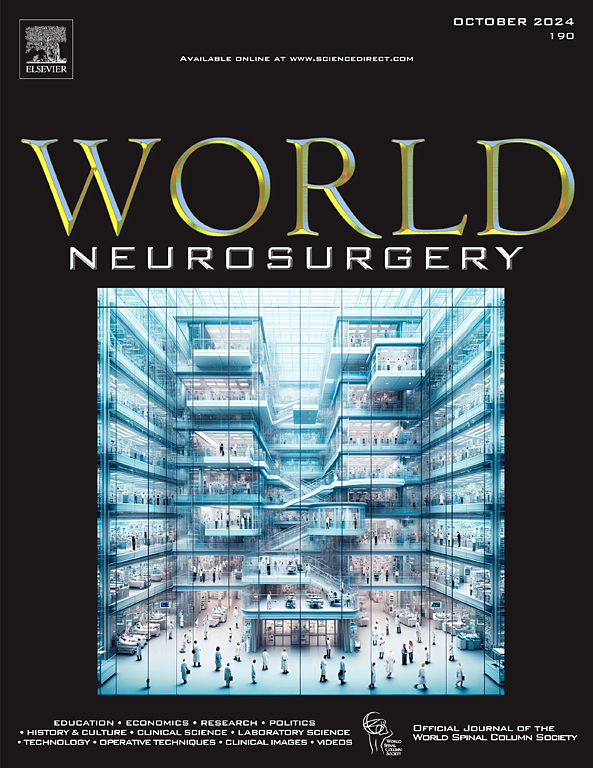化脓性脊柱炎患者经皮活检后,活检部位对细菌培养至关重要。
IF 1.9
4区 医学
Q3 CLINICAL NEUROLOGY
引用次数: 0
摘要
背景:既往研究发现疑似化脓性脊柱炎患者经皮穿刺活检后细菌培养阳性率受多种因素影响。同时,经皮活检穿刺部位的选择一直存在争议。目的:探讨化脓性脊柱炎患者经皮穿刺活检后细菌培养阳性率的影响因素。方法:回顾性分析首都医科大学附属北京胸科医院2023年1月至2023年12月行c型臂导穿刺活检术的186例疑似脊柱感染患者的病历。根据纳入和排除标准,共纳入116例疑似化脓性脊柱炎患者。计算细菌培养阳性率,并讨论年龄、性别、病程、术前发热、术前抗生素使用、术前白细胞计数、c反应蛋白(CRP)、红细胞沉降率、穿刺部位等因素对培养阳性率的影响。采用Logistic回归分析确定影响培养阳性率的相关因素。结果:116例患者中,男性63例,女性53例。年龄13 ~ 87岁,中位年龄59.5岁。42例患者细菌培养结果呈阳性,阳性率为36.2%(42/116),其中金黄色葡萄球菌12例,链球菌5例,布鲁氏菌5例,大肠杆菌4例,表皮葡萄球菌3例,铜绿假单胞菌2例,粪肠球菌2例,厌氧菌2例,其他细菌7例。椎体穿刺组细菌培养阳性率为22.6%(14/62),椎间盘穿刺组细菌培养阳性率为51.9%(28/54),两组差异有统计学意义(P=0.001)。Logistic回归分析显示,病程、穿刺前c反应蛋白升高、穿刺部位是影响培养阳性率的因素。结论:病程、穿刺前CRP升高、穿刺部位是影响化脓性脊椎炎患者经皮穿刺细菌培养阳性率的因素。经皮穿刺椎间盘穿刺阳性率明显高于椎体穿刺阳性率,提示椎间盘是更为关键的穿刺部位。本文章由计算机程序翻译,如有差异,请以英文原文为准。
The Biopsy Site is Critical for Bacterial Culture After Percutaneous Biopsy in Patients with Pyogenic Spondylodiscitis
Background
Previous studies have found that the positive rate of bacterial culture after percutaneous needle biopsy in patients with suspected pyogenic spondylodiscitis is influenced by a number of factors. At the same time, the choice of puncture site in percutaneous biopsy has been controversial. The objective of this study is to explore the factors influencing the positive rate of bacterial culture after percutaneous biopsy in patients with pyogenic spondylodiscitis.
Methods
The medical records of 186 patients with suspected spinal infection who underwent C-type arm-guided percutaneous biopsy in Beijing Chest Hospital Affiliated to Capital Medical University from January 2023 to December 2023 were retrospectively analyzed. According to inclusion and exclusion criteria, a total of 116 patients with suspected pyogenic spondylodiscitis were included. The positive rate of bacterial culture was calculated, and the effects of age, gender, course of disease, preoperative fever, preoperative antibiotic use, preoperative white blood cell count, C-reactive protein (CRP), erythrocyte sedimentation rate, and puncture site on the positive rate of culture were discussed. Logistic regression analysis was used to identify the relevant factors affecting the positive rate of culture.
Results
Among the 116 patients, 63 were males and 53 were females. Age ranged from 13 to 87 years, with a median age of 59.5 years. The results of bacterial culture in 42 patients were positive, with a positive rate of 36.2% (42/116), including Staphylococcus aureus in 12 cases, streptococcus in 5 cases, Brucella in 5 cases, Escherichia coli in 4 cases, Staphylococcus epidermidis in 3 cases, Pseudomonas aeruginosa in 2 cases, Enterococcus faecalis in 2 cases, anaerobic bacteria in 2 cases, and other bacteria in 7 cases. The positive rate of bacterial culture was 22.6% (14/62) in patients with vertebral body puncture and 51.9% (28/54) in patients with intervertebral disc puncture, and there was a significant difference between the 2 groups (P = 0.001). Logistic regression analysis showed that the course of disease, the increase of CRP before puncture, and the site of puncture were the factors influencing the positive rate of culture.
Conclusions
The course of disease, the elevation of CRP before puncture, and the site of puncture were the factors influencing the positive rate of bacterial culture in percutaneous biopsy of pyogenic spondylodiscitis patients. The positive rate of obtaining intervertebral disc in percutaneous puncture was significantly higher than that of vertebral body, suggesting that intervertebral disc is a more critical puncture site.
求助全文
通过发布文献求助,成功后即可免费获取论文全文。
去求助
来源期刊

World neurosurgery
CLINICAL NEUROLOGY-SURGERY
CiteScore
3.90
自引率
15.00%
发文量
1765
审稿时长
47 days
期刊介绍:
World Neurosurgery has an open access mirror journal World Neurosurgery: X, sharing the same aims and scope, editorial team, submission system and rigorous peer review.
The journal''s mission is to:
-To provide a first-class international forum and a 2-way conduit for dialogue that is relevant to neurosurgeons and providers who care for neurosurgery patients. The categories of the exchanged information include clinical and basic science, as well as global information that provide social, political, educational, economic, cultural or societal insights and knowledge that are of significance and relevance to worldwide neurosurgery patient care.
-To act as a primary intellectual catalyst for the stimulation of creativity, the creation of new knowledge, and the enhancement of quality neurosurgical care worldwide.
-To provide a forum for communication that enriches the lives of all neurosurgeons and their colleagues; and, in so doing, enriches the lives of their patients.
Topics to be addressed in World Neurosurgery include: EDUCATION, ECONOMICS, RESEARCH, POLITICS, HISTORY, CULTURE, CLINICAL SCIENCE, LABORATORY SCIENCE, TECHNOLOGY, OPERATIVE TECHNIQUES, CLINICAL IMAGES, VIDEOS
 求助内容:
求助内容: 应助结果提醒方式:
应助结果提醒方式:


